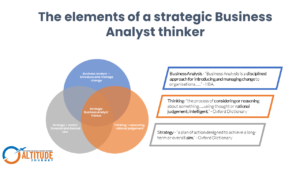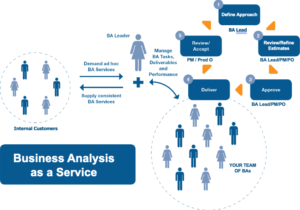Being strategic in your non-strategic business analysis role
We typically see business analysts as a tactical resource – eliciting requirements, analysing solution alternatives, determining the best approach for testing, and implementing a solution, defining non-functional requirements, etc.
This largely comes down to how we as a profession have marketed our ourselves.
The more valuable business analyst operates strategically and thinks strategically.
I am not talking about strategic business analysis; I am talking about being strategic. Even if you are a junior business analyst.
Benefit to strategic thinking in a business analyst role:
You can add a lot more value to an employer when you think strategically.
For instance, working through a problem by viewing multiple elements of and making meaningful comparisons allows the business analyst to come up with various options, and solution approaches to the problem.
If you want to take your career and leadership to the next level, you need to develop strategic thinking.
You need to be great at solving problems. You need to influence and lead your stakeholders through your strategic ability to solve these complex problems. The world is changing fast and you need to lead that change while leading people with you.
What does it mean to be a strategic thinker in business analysis?
We have kind of answered it in the introduction above, but let’s look at it in more detail.
We can define strategy as “a plan of action designed to achieve a long-term or overall aim,” – Oxford Dictionary
We define thinking as “the process of considering or reasoning about something….. using thought or rational judgement; intelligent,” – Oxford Dictionary
We define Business Analysis as “Business Analysis is a disciplined approach for introducing and managing change to organisations, whether they are for-profit businesses, governments, or non-profits.” – IIBA
At the intersection of these three, I believe we find the purpose of strategic thinking in business analysis. Above, I have highlighted the keywords that I believe help us understand strategic thinking in business analysis.
A strategic business analyst “introduces change to an organisation through consideration of organisational problems and opportunities identified, apply intelligent reasoning and rational judgement to the information available, analysing different factors or variables, to help the organisation not only identify the change but also manage the change, through a plan of action to achieve a future aim.”

Having this holistic view of what makes up strategic thinking in a business analysis role also helps us have a strategic thinking framework in our work.
This graphic I developed, using the three definitions above, help us define some framework for strategic thinking.
Element 1: We apply reasoning to business analysis work to determine the current and future state. Identify the gaps between the two and determine the change strategy and how it needs to be managed.
This is represented by the Business Analyst and Thinking circles intersection.
How do we do this?
There are three things we can do here to apply reasoning and judgement
- We use what we know about the organisation’s capabilities, resources, objectives, the environment within which the organisation operates, identify change and the impact of the change.
- We use the knowledge we have, the understanding of the organisational capabilities, the environment and other relevant information to guide stakeholders with expert reasoning and judgement.
- As business analysts, we can apply our judgement and reasoning to determine what that value is and maximise the value an organisation can get out of a change initiative. We help the business rationalise the reason for change, and that if it is worth the value to be gained.
Element 2: We apply reasoning to the strategy objectives (the intersection of the bottom circles)
If you think about the BABOK describes as defining the future state
“defines goals and objectives that will demonstrate that the business need has been satisfied and defines what parts of the enterprise need to change in order to meet those goals and objectives”
Thinking strategically is in your role is about applying your reasoning and judgement to the desired change and to identify what areas of the organisation are affected and how. Having a systems thinking that looks across all the following areas:
- Business processes,
- Functions within departments and systems,
- Functional areas and the interdependencies between them,
- Changes to the organisation structure,
- Staff competencies and the training/reskilling required,
- Knowledge and skills required in the organisation,
- Resources needed,
- Tools used within the organisation,
- The current and future locations of the organisation,
- Data and information – what data is required and what the flow is,
- Application systems needed, or enhancements to current ones,
- Technology infrastructure to host the systems.
Element 3: The last element that is found at the intersection of Business Analyst and the Strategy circles in the diagram.
The BABOK refers to identifying the transition states that address or ensure the change progresses. As a business analyst, we manage that change. This is not project management, but we certainly have a lot to do with helping to identify the things to manage the change in an orderly manner that adds value to the organisation.
The BABOK says that as business analysts we:
“enable the enterprise to address that need, and align the resulting strategy for the change with higher- and lower-level strategies,”
Managing the change, for me, is about ensuring that we have done all that is possible to not only identify the change, but how that change is going to happen and that we have thought through how this all works together to achieve a common aim. This means I apply my capabilities and thinking to ensure that:
- I help the organisation have outside in view of what is happening. This helps us, and stakeholders, to make rational decisions based on facts and not on assumptions.
- Provide an objective view of what is happening based on sound research and data. So, for instance, I might look at market movement, other industries, competitors, the economy etc and use data to predict future trends.
- Help stakeholders decide which route is best for the organisation and which changes will have most favourable outcomes in terms of value.
- To ensure the change strategy remains on track, a business analyst would have identified the major decision makers needed. Maybe even predict where each stakeholder is needed along each of the transition states.
- A business analyst defines and communicates the desired future state. Ensuring everyone is aligned with the desired change strategy.
- Sometimes organisations don’t know what they want. A good business analyst can work in extreme cases of uncertainty to steer their organisation to more certainty about what their needs are.
- A business analyst also needs to know how the change is going to happen, know each moving part, and how they will contribute to implementing the new future state. They create a clear, actionable plan that makes sense to everyone.
The original article, Using Strategic Thinking in a Business Analyst Role, goes on to explore the 7 habits to develop to aid your strategic thinking capability.





